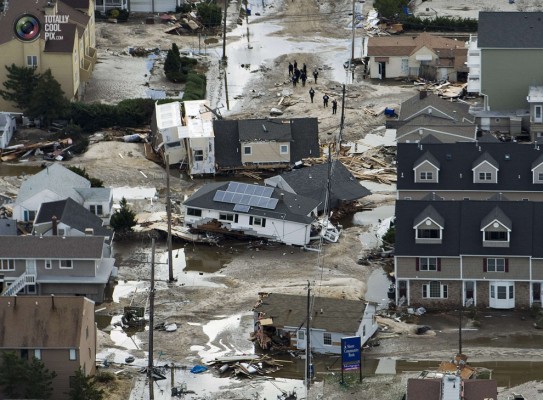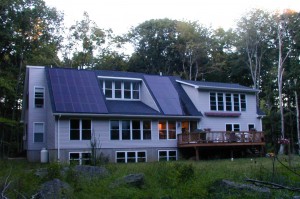Wonder if big storms like Superstorm Sandy might just pull solar panels right off the roof? There’s no absolute answers, as the Rocky Mountain Institute explains here, but in this case the home’s photovoltaic cells were more resilient than the foundation.

Hurricane Sandy knocked out most of the power along coastal New Jersey and New York, some of it still off, but photovoltaic cells and passive solar construction have created some bright spots.
Bayonne’s Midtown Community Elementary School is in the center, with the waters of Newark Bay visible in the background.

For example, the storm and its subsequent flooding had little effect on one school located roughly 600 feet from Newark Bay on a peninsula directly in harm’s way. While surging seawater wreaked corrosive havoc on the underground power lines that feed into Bayonne, New Jersey’s Midtown Community School, the campus has, and had, uninterrupted electrical service thanks to the prescience of local officials who eight years ago had a hybrid solar backup system installed. Unlike other PV systems installed at some Jersey school districts, which generate extra power to cushion operation costs, this system was designed to operate independent of the grid.
During emergencies, the school’s 232-kilowatt photovoltaic system shunts electricity generated by the solar panels away from the non-functional grid to a stand-by generator. Working in tandem with diesel fuel, sun-generated electricity saved enough energy to keep the generator running throughout the aftermath of the superstorm, and its smooth functioning provided a well-lit shelter for more than 50 evacuees.
Richard Schaeffer, who is in charge of the school’s facilities management, explained how solar saved the day. “Without our solar system on the roof of the school, we would have needed even more fuel, which would have been difficult to find because it was needed for all the repair trucks operating around the state.” All told, he said, the school’s supplier provided about 150 gallons of diesel a week ago and another 246 gallons a couple of days later.
According to Lyle Rawlings, whose company, Advanced Solar Products, installed the panels and ancillary connections to the uninterrupted power source, the legacy of Sandy and the success of solar during this harrowing period has led to a contract to build the first large-scale commercial photovoltaic-battery hybrid system ever.
A passive solar house in East Amwell, New Jersey.

Meanwhile, the image at right shows an off-grid passive solar house in East Amwell, New Jersey that also uses PV panels. (Keep in mind that solar panels do work on cloudy days, although not at peak potential.) While all other houses in the neighborhood had no power for more than a week and a half, the occupants here could keep their lights on. Since the house is situated and designed to also take in solar heat and effectively hold it in during night and inclement weather, the occupants likewise kept toasty while others froze.



